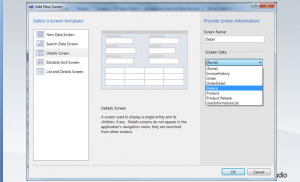Microsoft's LightSwitch: Building business apps for Web, PCs and cloud

Microsoft's "KittyHawk" -- a rapid-application-development tool targeted at fledgling coders who are interested in building business applications -- now has an official name: Visual Studio LightSwitch. It also has a public-beta download date: August 23.

Microsoft is positioning LightSwitch as a way to build business applications for the desktop, the Web and the cloud. It's a tool that relies on pre-built templates to make building applications easier for non-professional programmers. It's so easy, it's like flipping a switch, quipped Mendlen, in explaining the choice of final name for the product.
(Click on the screen shot at right to see what the LightSwitch interface looks like.)
"LightSwitch users can use as much or as little code as they want," Mendlen said. They can use Visual Basic or C#; they can connect their application to Excel, SharePoint or Azure services, he said. And they can target these apps to run anywhere Silverlight can -- in a variety of browsers (Internet Explorer, Safari, Firefox), on Windows PCs or on Windows Azure, Mendlen added. (Microsoft is planning to add support for Microsoft Access to LightSwitch soon, possibly by the time Beta 2 rolls around, he said. Support for mobile phones won't be available in version 1 of the product, Mendlen said.)
With LightSwitch, Microsoft is looking to blur the lines between development mode and run mode, Mendlen said.
"This hearkens back to Visual FoxPro," he said, "where you could develop and test at the same time."
When I wrote about KittyHawk, a number of my readers weighed in against the idea of enabling non-professional programmers to run business apps.
Microsoft needs to "(m)ake clear it's not a tool for Enterprise development. An awful high number of companies have Excel/Access atrocities powering real-world business transactions," said reader mnegrini.
Mendlen said Microsoft's idea is that LightSwitch users will be able to "hand offf their apps to professional Visual Studio developers to carry them forward," when and if needed. "Because LightSwitch uses the .Net Framework and Visual Studio core, the hand-off will be relatively simple," Mendlen said.
"We're saying if you are going to go rogue, use LightSwitch," Mendlen said.
Microsoft is expecting to release the final version of LightSwitch in 2011. It will be a standalone dev tool, but also could be part of one of the larger versions of Visual Studio, Mendlen said.
Update: Reader Paul Fallon asked how and if xRM, Microsoft's relationship-management platform -- which also is being used by some to create line-of-business applications -- fits with LightSwitch. According to a Microsoft spokesperson: "At this time there is no specific data connector for xRM, however it is possible to build a WCF RIA Service wrapper for xRM to make its data available to LightSwitch. This demonstrates the flexibility of LightSwitch. We are working to ensure we have the most commonly used data support for LOB apps, and through WCF RIA Services, other data may be made available."